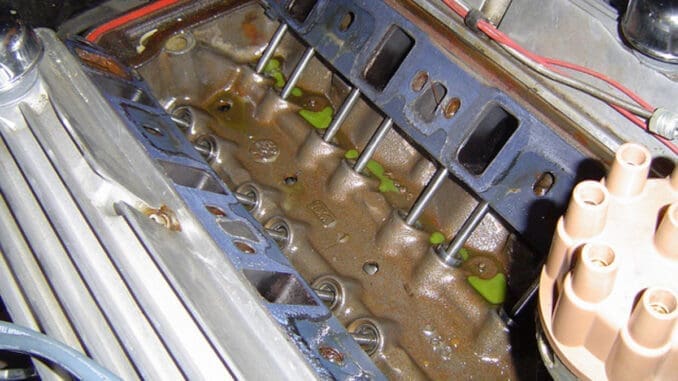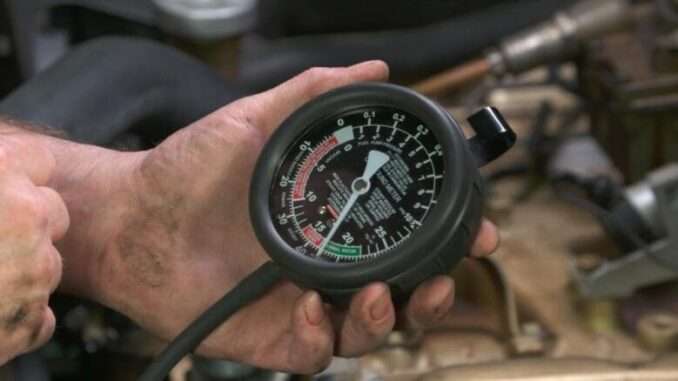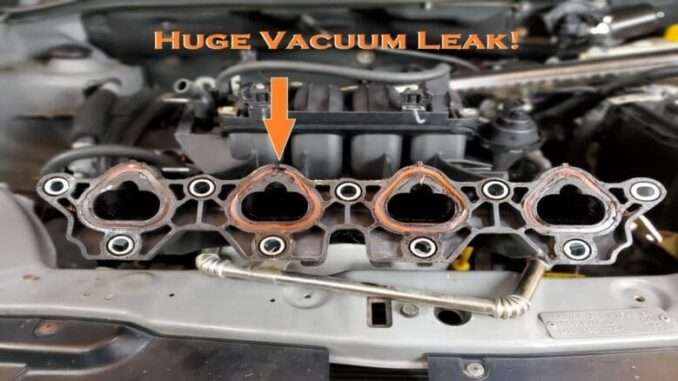
Intake Manifold Leaks, are the most common leaks found in an engine.
Consequently, intake manifold leaks, are usually, the fault of the gasket. That gasket, can be made of paper, rubber, metal, and sometimes a combination of the three.
Intake manifold gaskets, are responsible for sealing the intake manifold, against the cylinder head(s). Apart from sealing engine vacuum, certain intake manifold designs, will also seal engine coolant or even oil.
As a result, having any Intake Manifold Leaks, will spell trouble for your engine. When the intake manifold gasket has an issue it can cause drivability problems, and even engine overheating. Usually a faulty intake manifold gasket, will produce a few symptoms, that can alert the driver of a potential issue.
That is why you need to learn about what the symptoms are, of a leaky intake manifold gasket. Once you recognize this, you can proceed to fix the problem, without wasting any more time.
On engines with aluminum cylinder heads, corrosion typically erodes, the area around the coolant ports.
So, some manufacturers, redesigned the intake manifold service gaskets, for some of the problem applications. As a result, they’ve changed the sealing beads, from silicone rubber to a tougher material, called fluoroelastomer (FKM) rubber. This is much more resistant to oils, solvents and chemical attack.

Consequently, the location of the sealing beads on some gaskets, has also been revised. The original OEM gaskets, as well as the revised service gaskets, are usually black with orange sealing beads.
Diagnosing, Intake Manifold Leaks
Let’s Start With Vacuum Leaks.
Vacuum Leak Symptoms:
- Backfiring
- Hesitation
- Hard starting
- Low engine power
- Misfiring
- Poor fuel economy
- Poor acceleration
- Rough idle
- High idle
- Stalling
- Stumbling
- Check engine light on
- Poor brake performance (on vacuum type power brakes)
Also, keep in mind that these symptoms, are not exclusive of a vacuum leak:
- A bad (EGR) valve
- Poor compression
- Ignition timing problems
May cause one or more of these symptoms as well.
Testing, For Vacuum Leaks
A fuel trim problem can occur, if the intake manifold has the tiniest leak. If you just use your eyes and ears to find the leak, it can take a very long time. So, anytime air leaks through the intake manifold, it will cause air to get sucked in. Whatever is in the air, that’s pulled in will compromise the air/fuel mixture. As a result, this will impact the emission and the engine systems.
But, if you have a smoke machine, then multiple leaks can be diagnosed, in a shorter amount of time. This machine does this by, allowing the intake manifold to become pressurized, while placing vapor and smoke into the system.

So, if intake manifold leaks truly does exist, then smoke will be pushed out. Firstly, find a vacuum port and attach the smoke machine to it. Ensure that you have the right sized plug, when blocking the throttle body. Then, the (PCV) system, must be blocked off as well. Finally, check if the (PCV) system or oil filter, has smoke coming out of it.
Testing For, Internal Vacuum Leaks ( V6/V8 Engines)
Most of the time this will also, cause high oil consumption. Seal off all openings, remove the (PCV) valve and plug it. Remove the dipstick and attach a vacuum gauge, to the dipstick tube. Start the engine. Pulling one to three inches of vacuum, is normal. But, pulling anything from, eight to eighteen, confirms an internal vacuum leak.

This Could Mean That:
- The lower gasket, has slipped out and is leaking.
- Matting surface angles, are not lining up properly.
- There is a crack, in the intake manifold.

Coolant Leak, Symptoms:
- Loosing Coolant
- Engine Overheating
- No Heat
- Engine Codes
- Signs Of Foaming Or Other Contamination In Oil
- Rough Idle
- Engine Backfiring
- Washed Clean Spark Plug
This may produce a distinct coolant smell, along with steam and drips or puddles of coolant, underneath the vehicle. A coolant leak, will eventually lead to engine overheating, when the coolant level drops too low. Also, there are instances where overheating can occur, without any visible leaks. If damage were to come to the seal, all the pressurized coolant it is holding back, may seep through it.
Often times, the coolant will have, debris and dirt inside of it, which will create even more problems. If the debris is thick enough, it will cause more wear on the surfaces. Not only that, leaky coolant will also cause, air from the outside to get into the engine, through the seal. Finally, anytime oxygen is present, it will totally increase, the amount of corrosion that forms.
As a result, this will cause, even more damage to the surface. Consequently, if there were to be a change in the level of air or fuel in this mixture, it would have a negative impact on the performance of the engine.
Once that happens, the symptoms will typically be, rough idling and numerous backfires. If coolant leaks on the outside of the gasket, then you can see it. However, there could be internal intake manifold leaks, that go into the oil or combustion chamber. As a result, you won’t be able to spot them.
Testing, For Coolant Leaks
So, what you’ll want to do is, give your system a complete inspection. Start by checking the oil, for signs of foaming or other types of contamination.

You should also pull any codes, so you know exactly what you’re dealing with.
For instance, if the codes relate to the oxygen sensor, then you may have coolant in the combustion chamber. Coolant will cause damage, to the catalytic converter and the oxygen sensor.
So, if you have a V8 or V6 engine use the codes to figure out, which bank has the leak. Because, any big leaks that are in the runner, may give you a misfire code. So, if you experience this problem for extended periods of time, take out all the spark plugs. Check if they have any, chalky white deposits on them. Consequently, this is a sure sign of a coolant leak.
Conclusion
Finally, by following these techniques it will help you determine, where the intake manifold leaks are coming from.
BY DANNY BENDER




